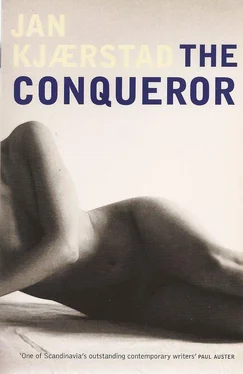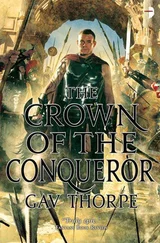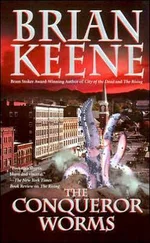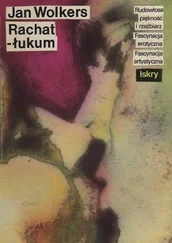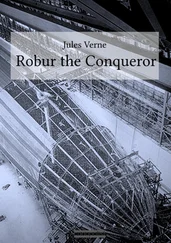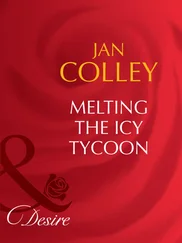The Amundsen programme was full of scenes that caused viewers to avert their eyes. During the last hectic days of shooting outside today’s Gjoa Haven, just before the advent of spring, Jonas Wergeland had been granted permission to reconstruct an old-style hunt for the first wild reindeer of the year, which were felled on land with bows and arrows. Jonas got in plenty of close-ups from the slaughtering, showed the slashing of the knives — most of them pretty primitive — showed the blood, the entrails, the meat being warmed, people gobbling it down, people cracking bones and slurping up the marrow, people scooping up the contents of the reindeer’s stomach and drinking them down; there were pictures of raw meat, dripping grease, bloodstained fingers and lips, dogs baring their teeth: a glimpse of life pared down, quite literally, to the bare bones. And in the midst of this steaming tableau: Roald Amundsen, looking exactly like an Eskimo.
Here and there Jonas had inserted shots from the collection of Netsilik weapons and artefacts which Amundsen had brought home with him and which was now on exhibit in the Ethnographic Museum in Oslo. With this montage he managed to say something about the gap between the dusty, neatly-arranged glass cases — Jonas himself had found this place deadly boring as a child — and the bloody, ice-cold reality, what a far cry it was from that incredible hunting aid, the kiviutchjervi , as it looked hanging on the wall of the museum, to an actual seal hunt. In one long sequence, filmed in total silence, Jonas Wergeland showed how the Netsilik caught the little fur seals found in that area; how first, with the dogs’ help, and often through a layer of snow several feet deep on top of the ice, they located a breathing hole and how they then, by dint of a number of remarkable devices, chief among them the aforementioned kiviutchjervi , which consisted of a length of reindeer sinew and some tiny bits of wood with a piece of swansdown stretched between them — in actual fact an ingenious sensor which told them when a seal was approaching — were finally able to drive the three-pronged harpoon into the seal, even through a thick layer of snow, just as it was coming up for air. This was the high point of the programme, and Jonas did not stint when it came to detailed shots of the seal lying at last on the ice and the hunters ripping out the liver and kidneys and eating them right there and then, raw. He followed this with a scene inside an igloo, where the animal was being skinned and quartered with the ulo and its entrails dropped into a pot for heating up. As people watched white teeth munching on such delicacies as the seal’s eyes and brains they could almost smell the whale oil burning in the lamps, hear the dogs howling and feel the bite of the icy polar air. Some viewers claimed that they sat there shivering in front of the screen. And afterwards they got themselves something to eat. ‘I’ve never been as hungry,’ was the comment from NRK’s own director.
Amundsen was no hunter, he didn’t like hunting, but you had to take life if you wanted to survive, kill with your bare hands if necessary. Even so, there was something terribly barbaric about this programme; it was just a little too raw and primitive. There were some who felt that Jonas Wergeland had used unnecessarily shocking effects, as if he were out to break some taboo. I don’t suppose anyone would have been surprised to find that just such a programme, containing so much bloody harpooning of seals, so many red-stained patches of ice, would be studied carefully by forensic psychiatrists, when the man who had made it turned out to be a murderer.
Jonas Wergeland was also accused more than once of being a con artist. Certain experts maintained that he had chosen the less well known, or at any rate, less well documented aspects of the series’ heroes for obvious reasons: he didn’t know the first thing about them. By highlighting a less well-recognized facet of a character he ensured that fewer people could check the accuracy of the scenes he presented — and the fact that he focused on just one aspect of his heroes’ lives meant that the majority of viewers also believed Jonas Wergeland knew everything about them, that he was just as well informed about the rest of their lives. That is not for me to decide, Professor, I will simply say that if Jonas did not know almost all there was to know about Amundsen, then he hid it well.
More serious was the assertion that he used the same key to an understanding of all his subjects. He presented them as mediocrities or, to be more precise, mediocrities in every area except one. One could, therefore, be tempted to say that he modelled them on himself. Every one of them had a unique gift for which they found a special use. In Amundsen’s case it was his stubborn, obsessive efforts to learn by experiment — even to the extent of wearing in a new pair of expedition boots by walking up and down Karl Johans gate in them; an almost alarming determination when it came to acquiring as much knowledge as possible about how to survive in snow and ice, in extreme cold. As I say: Roald Amundsen was a champion when it came to doing his homework. Without this, no Norwegian flag at the South Pole.
For what it is worth, I think it would be truer to say that Jonas Wergeland did not create these people in his image, but that he did try to give himself some hope, by depicting his heroes in the way that he did. If there was any truth in his portraits of Amundsen and the others — well, then there was hope for him, too. Jonas Wergeland wished, in other words, albeit latently perhaps, to create, or attempt to recreate, himself through the images of his subjects. In any case, he saw no point in celebrating a person who had everything going for him and achieved his goal. There was, however, good reason to salute someone who, despite their limited abilities, succeeded in conquering a corner of an unknown world. The message Jonas Wergeland wished to convey was a hopeful one: one, just one, great thought can be enough. One single, unusual thought — and you can do something that no one has done before.
In the short run, though, no one was thinking along such lines. Since the Amundsen programme was sent out during the winter, people were too busy rushing out into the snowdrifts. All over Norway courses in igloo building were suddenly being arranged. The Evening News did a piece on a hardy family with young children who had lived in a snow-hole for a full week. Jonas Wergeland himself could confirm that there had never been so many ice-fishers on the lakes around Oslo — it was, as he said in an interview, as if the Norwegians had suddenly discovered that they were Eskimos at heart.
I still refuse to accept that this cannot be done, Professor, for when Jonas Wergeland stood there with his finger on the trigger, aiming straight at Margrete’s heart, he was still thinking, upset though he was, about the minutes immediately prior to this, when he had seen her sitting with a golden orange in the vacuum between the flickering light of the television and the fading light outside the window, dark-blue with a yellow band at the bottom; he stood there watching the way she contemplated the orange, as if she got more out of the thought of the wonder that it represented, than he got out of a whole World’s Fair; and it is then that he plucks up his courage and says he has to talk to her, and he tries not to say it but says it anyway: ‘Are you still having an affair with Axel?’ — and he thinks she hasn’t heard him, thinks she is too busy watching the television, and ‘Thank heavens’ he thinks, but then she gently puts down the orange and she gets up, and she stands there in his dressing-gown, his dressing-gown, and she looks deep into his eyes before saying: ‘What do you mean?’ — a question so arrogant that he starts yelling, and although she is obviously trying to control herself, she is unable to bite back the short laugh he heard for the first time when the ice palace came tumbling down on Steinbruvannet, and he has to scream at her, don’t stand there and deny it, don’t you bloody dare, you whore, because somebody had told him, she’d been caught in the act, don’t fucking stand there and think you can fool me, because he knows, dammit, he had met someone who knew the whole story, he says and feels the pistol burning a hole in his pocket, a pistol he had had absolutely no intention of using but which all at once is burning a hole in his pocket, suddenly telling him that he might end up pulling it out anyway, at any moment, in fact — a possibility he could never in all his life have conceived of when he packed his case and left for Seville.
Читать дальше
